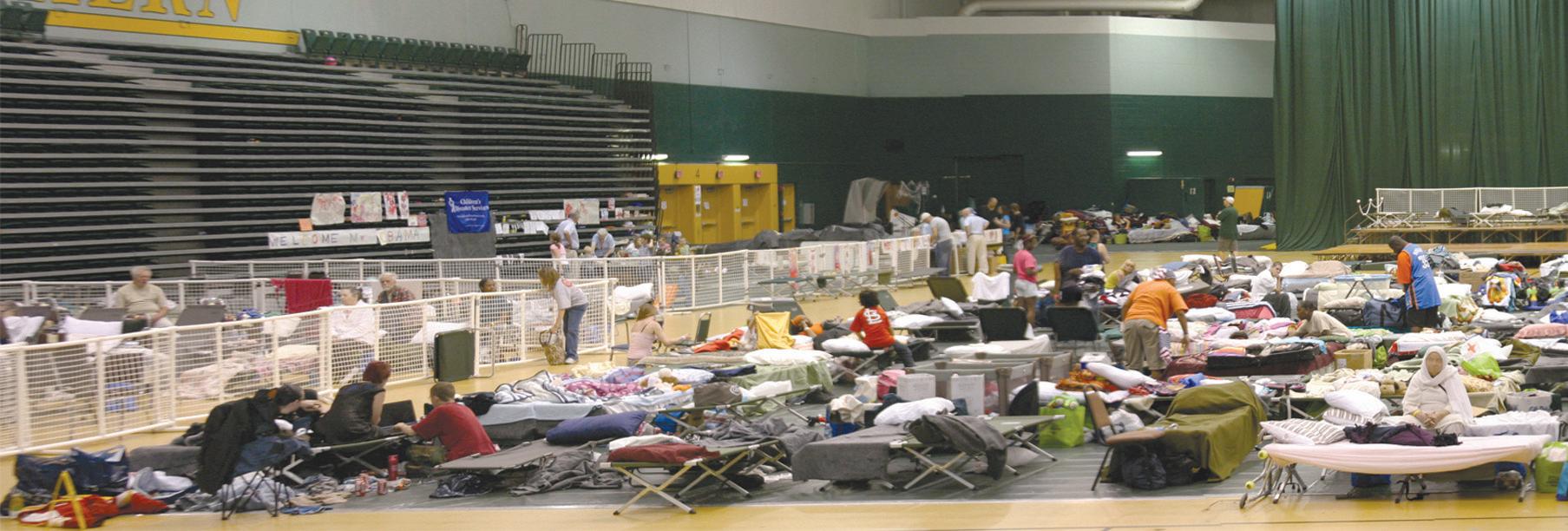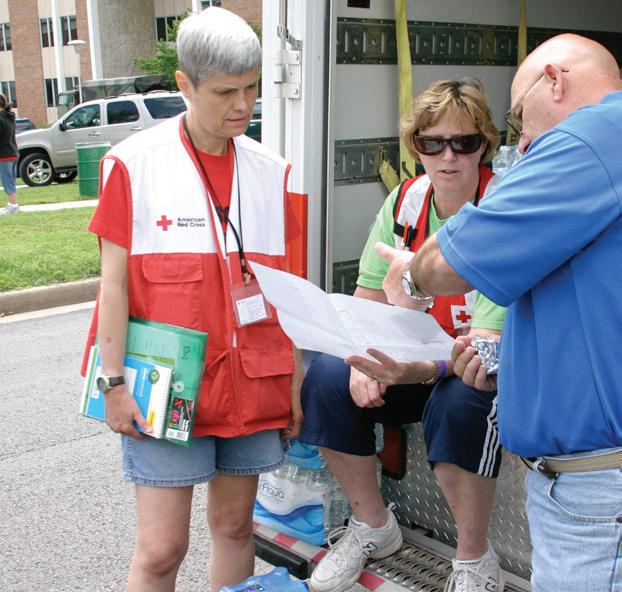
11 minute read
Meeting the needs
Volunteers sign up to help after May 22 in the Beimdiek Recreation Center. — Photo by Lee & Wyrsch

Advertisement

Missouri Department of Public Health offers free inoculations at an informational session hosted by the governor on May 26 on the Missouri Southern campus. Below, Maureen Burke, Missouri Department of Emergency Management, talks to a Joplin resident at the
informational meeting. — Photos by Rhonda Clark, ’00 Above, Paul Cheatham carries Maggie Ward, 8, from her home to emergency personnel on May 22. This photo by Mike Gullett, communication adjunct faculty member, appeared in USA Today. Below, workers use heavy machinery to lift loose debris into a truck for transport to area landfills. The large, black trucks were a common sight throughout the summer as the area raced to meet a FEMA deadline in August for removal of loose debris. — Photos by Mike Gullett







Southern works to help a community find the strength to recover and heal.
Children laughed and bounced on an inflatable slide or had their faces painted outside of Fred G. Hughes Stadium. The sounds of Offset Sunset, a local band comprised of Missouri Southern students, reverberated off the stands. Excited students, parents, teachers and administrators greeted each other and gathered school supplies that were being given away inside Leggett & Platt Athletic Center.
What a difference a few months can make. Throughout the summer, the Southern campus served as a staging site for many agencies to help the community recover after the tornado. But by August, most everyone was ready for fellowship and remembrance. The event on August 10 brought together thousands of people in the Joplin R-8 School District for the first time since the storm abruptly ended the 2010-11 school year. The event, “I Am Joplin,” was the first of many that would signal signs of healing on the campus, which witnessed much heartache along with hope in the weeks following May 22.
A perfect storm
Craig Richardson, coordinator for fire safety and environmental health at Southern, knew as the police scanner squelched reports in the minutes after the tornado that this was a massive catastrophe. He had ridden out the storm with his wife at their home in north Joplin before contacting Rob Yust, ’80, vice president for business affairs. Richardson wanted access to emergency supplies and vehicles so he could help in the community. Before he could get that chance, a call came in that the Greater Ozarks Regional Chapter of the American Red Cross would be setting up a shelter on campus.

Left, a volunteer at “I Am Joplin,” August 10 at Southern, holds a parachute as children play. Above, Offset Sunset, a local band comprised of Southern students, plays at “I Am Joplin” on the field at Fred G. Hughes Stadium. — Photos by Willie Brown, ’13
DID YOU KNOW?

45,556
Number of volunteers who arrived on campus after the tornado to sign up to work with AmeriCorps, a network of national service programs, which set up a staging area in
Billingsly Student Center and organized cleanup efforts across the swath of destruction.
3,000+

Number of meals prepared per day by Sodexho in the first four days after the tornado struck.
73,926
Approximate number of meals served at the Red
Cross shelter in Leggett & Platt Athletic Center before it closed June 12.
3,032
Approximate number of people served overnight at the shelter before it closed.
1,000+
Approximate number of people treated at the
Health Sciences Building triage before it closed on
May 27.
The Leggett & Platt Athletic Center looked much the same that evening as it had in the afternoon. Joplin High School had graduated almost 500 seniors that day. Chairs littered the gym floor, and green curtains and the R-8 school district crest provided a backdrop to the empty stage. Just the day before, Southern’s graduates filled the same area. Within hours, a place for celebration turned into a refuge for the displaced.
Communication was limited to text messaging, which helped alert Southern employees of the urgent needs on campus. They worked alongside Red Cross volunteers setting up cots.
“Our people were everywhere,” Yust said. “You couldn’t throw a stick without hitting a Missouri Southern person. They just showed up.”
Kelly Wilson, ’80, head of the Advising, Counseling and Testing Services office, and her staff headed to campus after a text about 9 p.m. from Darren Fullerton, ’88, vice president for student affairs.
“People were coming in and they had that dazed look,” Wilson said. “It was raining, so they were coming in wet, and some of them were injured and didn’t even realize they were injured. We served the immediate fundamental needs of shelter. Then the donations started coming in immediately — water, clothing, toiletries — so we were busy trying to organize that.”
Richardson noticed something else as people came to Southern seeking shelter — he recognized many of them.
“It takes your breath away,” he said. “You feel kind of helpless, and you want to help, but you’ve done what you can at this point. You’ve given them shelter, food, a shower, but you want to do more. You know there isn’t more you can do, and your heart went out to them.”

Helping hands
Dr. Tia Strait, ’85 & ’93, dean of the school of technology, was at home in Carthage, Missouri, when Brenda McDaniel, who works in the registrar’s office, called to tell her to turn on the Weather Channel.
“Brenda said, ‘What do you think?’ I said we needed to go get the Health Sciences Building ready for patient care,” Strait said.
The new Health Sciences Building quickly transformed from a classroom facility to a 29-bed hospital. Faculty, staff, students and volunteers treated the wounded who came to campus. The service was direly needed, as Joplin faced a crisis with one hospital out of commission and another taxed to its limits.
“By Tuesday, we were caring for the rescue workers who got injured in the field,” Strait said. “By the second day, we started seeing a strong need for mental health specialists.”
Two Southern counselors, Faustina Abrahams and Mary Parker, received a quick training course in crisis and grief counseling from the Red Cross. It was helpful to have locally trained professionals to assist with those traumatized by the storm and provide “mental health triage.”
Aaron Lewis, ’99, athletics facilities coordinator, and his staff worked tirelessly to provide for those seeking shelter, including their pets. By Monday, a surplus of donations necessitated a move of the items to nearby College Heights Christian Church.
“An event like this definitely changes your perspective of this campus and who you work with,” Lewis said. “I’m proud of this campus for all of the work that was accomplished during that time and of what they continue to do.”
The campus had water but reduced pressure. Richardson said Missouri American Water Company placed a priority on correcting the situation, as hundreds of people poured into the facilities. Until pressure was restored, Mike Fox, maintenance technical supervisor, and the custodial staff used ingenuity to keep things flowing.
“They used large trash cans filled with water from the swimming pool to keep the toilets flushed. That was a huge help,” said Bob Harrington, ’98, director of the physical plant.
Richardson said another problem arose as news of the temporary morgue, set up on Lot 18 just south of Hughes Stadium, circulated through the shelter. The close proximity created security concerns as people looked for the missing. By Monday evening, the morgue had moved to an undisclosed location in Jasper County.
Temporary home base
Southern had signed a Memorandum of Understanding with the Red Cross less than a month before the May 22 tornado. The university would provide space for the shelter, but what campus of-

ficials hadn’t counted on was the number of other agencies needing staging areas.
Few buildings went unused in the weeks and months after the storm. The residence halls housed first responders, military personnel and governor’s staff members.
“We were the only facility big enough that was up and running,” Richardson said. “There was nowhere else. Ozark Christian College had been turned into the command post for the Red Cross, which took everything over there. We were it, basically.”
For almost four weeks, employees were relocated to other areas, as the university accommodated the agencies, Fullerton said. Even the simplest items, like extra telephones, were in short supply, and the IT department struggled to keep up with technology requests.
University Relations and Marketing Director Rod Surber and his office coordinated local, national and international media outlets that converged to cover the story, with the help of volunteers from Drury University and MSSU students and staff. Surber set up areas for the governor to conduct press conferences and meetings.
A governor-sponsored Community Resource Meeting, which brought together multiple state agencies on May 26, attracted several thousand to campus, looking for help and support.
“We were overwhelmed by the amount of work that needed to be done to coordinate the events, and then the president’s visit a week later,” said Surber.
The Joplin Community Memorial Service, at which President Obama spoke, created unique challenges.
“We had to find curtains and extra stanchions for security as well as flowers for the stage,” said Surber, adding that local florists donated about $3,000 worth of flowers. “We had one florist who had lost her home in the tornado, but she was thrilled to be able to do something to help out with the service.”
His office did receive encouragement that week. Staff at the University of Alabama, which was affected by the April tornado that hit Tuscaloosa, sent a care package to show support.
Sodexho, the campus food service, fed people in the shelter, volunteers and first responders, in addition to delivering meals to the disaster areas.
“Mike Wonderly (director) and Sodexho did a fabulous job,” Harrington said. “The response from the university was absolutely phenomenal. Everybody just jumped in and did whatever was needed. Some of our custodians worked 20 to 40 hours straight without going home.”
Once the initial crisis was over and the residence halls emptied, displaced faculty, staff, students and their families would call the rooms home until more permanent housing could be found, Fullerton said. Things did not subside altogether, however.
“Even though the immediate response happened in the first few weeks, AmeriCorps and FEMA were on campus until August, so we were really in tornado response throughout the whole summer,” he said.

Moving forward
Like the Joplin schools event on August 10, Southern continues to be a place for healing and restoration of a devastated community. The campus is still used for citywide meetings as well as concerts and other events to raise money and hope for the area. Many have discovered Southern’s love and spirit.
“I’m proud to be an employee and I’m proud to be an alum of this institution,” said Wilson, who has worked at MSSU for 25 years. “I always have been, but it’s heightened because of all of this and what we’re doing and what we’ve done.”
Southern’s response to the crisis hasn’t gone unnoticed. Richardson said the governor’s office requested a copy of the Memorandum of Understanding with the Red Cross to see if other universities should have similar agreements.
And, Yust is working on a master plan of facility use to streamline the organization process.
“We were flying by the seat of our pants, but it turned out OK,” he said.
Fullerton, who was about to head out with his son to Academy Sports on May 22, decided to wait out the storm. Academy was one of about 500 businesses destroyed that evening. The tornado has given him a new perspective.
“As a campus and individuals, we need to really focus on the moment,” he said. “It’s made us realize we might not have later.” — Rhonda Clark, ’00
DID YOU KNOW?

551
Number of volunteers who worked at the Health Sciences
Building triage unit.
DMORT
The Missouri Department of
Public Safety and the federal
Disaster Mortuary Response
Team occupied the third floor of Billingsly Student
Center, where professionals from across the country conducted DNA testing to assist in identifying the deceased. Willcoxon Health
Center housed Missouri
Highway Patrol officials, who took reports from people looking for loved ones and also counseled families who were given the sad news when the missing became a death statistic.
Agencies on campus:
American Red Cross
AmeriCorps
FEMA
SEMA
HUD
IRS
Small Business Administration
Department of Social Services
Department of Public Safety
Missouri National Guard
State Treasurer’s Office










